
Feature Articles
I. Food Safety Seminar for Trade cum Food Safety Charter 2009 Presentation Ceremony

While there is a Chinese saying that "Food is people's paramount concern", we should pay attention to food safety when enjoying food. Therefore, although I am a food lover, I am also very careful in choosing food. I often visit the website of the Centre for Food Safety (CFS) to keep abreast of the latest information on food safety. Some time ago, I learned that a biennial Food Safety Seminar for Trade would be held by the CFS in September. The aim of the Seminar was to provide a forum for interactive exchange of information and views on important food safety issues in Hong Kong between the food trade and the Government. Hence, I talked to the chief editor and volunteered to make a report on the event.
The Seminar was held at the Lecture Theatre of Hong Kong Central Library on 17 September 2009. The officiating guest, Dr Constance CHAN, Controller of the CFS, delivered the opening speech, while a number of Government officials briefed the trade on the latest information on food safety legislation, guidelines and other related issues.
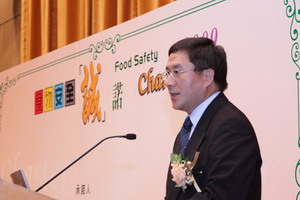
This year, special sessions were included in the Seminar to brief the trade on the "Food Safety Charter 2009" and the results of the Survey on "Five Keys to Food Safety" (Five Keys). The "Food Safety Charter 2009" Presentation Ceremony was also conducted at the same time. Officiating guests included Mr CHEUK Wing-hing, Director of Food and Environmental Hygiene, Mr WONG Yung-kan, Deputy Chairman of the Legislative Council Panel on Food Safety and Environmental Hygiene, Mr Tommy CHEUNG Yu-yan, Member of the Panel, and Dr Constance CHAN, Controller of the CFS. In his speech, Mr CHEUK commended food traders for their positive response to the promotion of the Five Keys. He said the signatories had not only pledged to disseminate the messages of the Five Keys to their staff, but also put the food safety measures into practice in their premises.
Through the "Food Safety Charter", the CFS hopes to gear up the community efforts to promote the Five Keys and enhance food safety. This year, the Charter has also introduced a recognition scheme for food trade associations and licensed food premises that sign up to the Charter for three consecutive years. The public can identify the signatories through the display of the certificate and sticker of the Charter inside their premises as well as the badges worn by their staff.
Representatives of food trade associations signed up as the signatories in the presence of the officiating guests at the Ceremony. After receiving the certificates from the guests, the signatories immediately showed them to their members and participants at the Seminar to demonstrate their determination to promote and practise the Five Keys.
21 food trade associations and over 1 700 licensed food premises / supermarkets / convenience stores signed up to the Charter this year. Information on the signatories is available at both the CFS website (www.cfs.gov.hk) and the roving exhibitions held in various districts, which is really good news for food lovers like us.
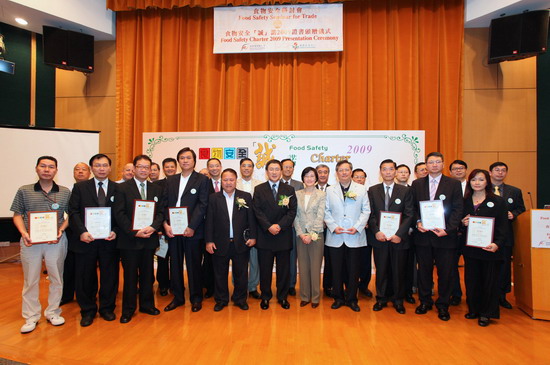
II. Safe Festive Food for a Happy Chinese New Year
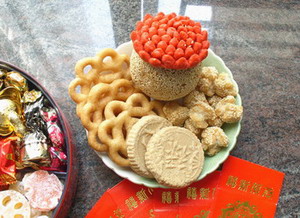
The Chinese New Year is just round the corner. People will buy festive foods with good omens, such as new year cakes, deep-fried dumplings, glutinous rice dumplings, abalone and preserved pork, for serving guests and families. Good in both appearance and taste, they indeed can spice up the festival. However, if handled, stored or consumed improperly, they may pose a risk of disease. To have a healthy and happy Chinese New Year, the public are advised to pay attention to the following tips when buying or preparing festive foods.
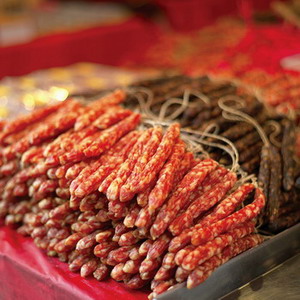
- Careful Selection
- Buy festive foods from reliable and hygienic shops;
- Buy traditional snacks like sweetened lotus seeds and sweetened melon with natural colour and avoid those looking extraordinarily white because they may have been bleached;
- Avoid buying melon seeds that are too glossy as mineral oil may have been added during the production process, which may cause gastrointestinal discomfort;
- Check the expiry date when buying any prepackaged festive items like puddings, sesame balls and sweets. Make sure the packaging is intact;
- When buying unpackaged items like crispy triangles, sesame balls, sweets and melon seeds, note the hygienic conditions of the shop and the food containers, and observe whether its staff maintain good personal hygiene.
- Proper Storage
- After purchase, pre-cooked foods like puddings should be stored in a refrigerator as soon as possible and be consumed before the "Use by" date shown on the packages;
- Fried festive foods, such as sesame balls and crispy triangles, should be kept in air-tight containers and stored in a cool, dry place to avoid deterioration.
- Healthy Consumption
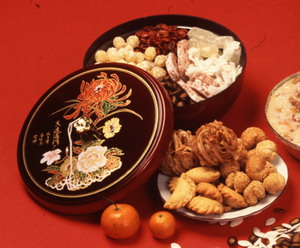
- Use a dehulling machine for melon seeds to avoid contact between the mouth and the hulls;
- Soak and clean thoroughly dried seafood and specialties, such as dried shrimps, before cooking. Discard the water used for soaking;
- Refrigerated puddings should be reheated thoroughly before consumption;
- Stop eating and discard puddings found mouldy or with an abnormal taste. Abnormal taste indicates that the puddings have perished due to improper or prolonged storage.
III. Ethyl Carbamate in Fermented Foods


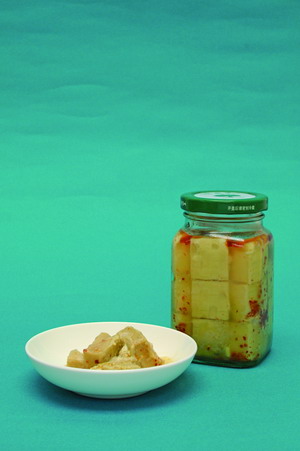
Ethyl carbamate (EC) (also known as urethane) is naturally formed in fermented foods and alcoholic beverages during the fermentation process or during storage. Various substances derived from fermented foods and beverages, including urea, hydrogen cyanide, citrulline and other N-carbamyl compounds, are precursors of the formation of EC. The level of EC in foods depends on the amount of precursors, and will be increased with elevated temperature, presence of light and duration of storage. Variable levels of EC have been found in different fermented foods, such as bread, soy sauce and yogurt, and in alcoholic beverages, such as spirits, grape wine and beer. The International Agency for Research on Cancer assessed EC and classified it as "probably carcinogenic to humans". In that connection, the CFS conducted a study, in which the level of EC was analysed in 276 food and beverage samples including 70 alcoholic beverages.
In the analysis, EC was detected in 202 samples. Fermented soy products (fermented red bean curd, fermented bean curd) and alcoholic beverages (yellow wine, sake and plum wine) were among the food items found with relatively high EC levels, while other fermented foods, such as fermented cereals and grains products, preserved vegetables, fermented dairy products, fermented fish products (salted fish) and fermented tea (Chinese tea), contained low or non-detectable levels.
According to the result of the study conducted by the CFS on the level of EC in local fermented foods and beverages, the food group "alcoholic beverages" was identified as the main dietary source of EC, followed by the "fermented cereals and grains products" and "legumes". For the general population, dietary exposure to EC from normal consumption of fermented foods and beverages is unlikely to pose health concern. However, for consumers with high alcoholic beverages consumption, health risk of EC cannot be ruled out.
Advice to Consumers
- Maintain a balanced diet. Avoid overindulgence in fermented foods and beverages, in particular alcoholic beverages.
- Store fermented foods and beverages in a cool place under low light conditions.
- Avoid stocking up excessive fermented foods and beverages to minimise the duration of storage.
The report of the Study on Ethyl Carbamate in Local Fermented Foods is available on the CFS website:
http://www.cfs.gov.hk/english/programme/programme_rafs/files/RA39_EC_in_food_e.pdf
Readers' Corner
I. Disposable plastic containers and food safety
Frequently Asked Questions & Answers:
1. What are the disposable plastic containers used by the local food trade actually made of?
Disposable plastic containers commonly used by the food trade are often made with four types of material: polypropylene (PP), expanded polystyrene (EPS, commonly known as polyfoam), polystyrene (PS) or polyethylene terephthalate (PET).
2. What kinds of disposable plastic containers should we choose to keep food?
When choosing disposable plastic containers, take into account the characteristics of the food to be contained, such as whether the food is acidic or oily, the temperature of the food and the duration of contact. Among the four types of material mentioned above, PP plastic containers have better heat resistance properties and can be used for holding food with temperatures between 100℃ to 120℃. The other three types of material with relatively poor heat resistance are not suitable for keeping food over 100℃. If these containers are to be used, the food should be cooled down before putting into them.
3 What should we pay attention to when purchasing take-away meals?
When purchasing take-away meals, we should pay attention to whether the containers containing the food are deformed or not. If in doubt, discard the food contained and contact the supplier or restaurant concerned for assistance.
4. Can we reheat take-away food in disposable containers in microwave ovens?
When using microwave ovens for reheating take-away food, ensure that the containers are suitable for use in microwave ovens. For example, EPS containers are not microwavable. If in doubt, reheat the food in a microwavable container.
5. Can disposable containers for take-away foods be reused for reheating purpose?
Disposable plastic containers that are microwavable are generally designed for single-use only and should not be reused or reheated in microwave ovens more than once.

II. Enjoy a Safe Buffet

| Andy : | Every Friday, Saturday and Sunday, buffet at $168 per head, and six for the price of five. The price per head: $168 times five divided by six…… |
|---|---|
| Chuen : | Andy, why do you keep turning the pages of the food magazine? |
| Andy : | Friday is my daughter's birthday. The whole family will be having a buffet dinner to celebrate her birthday. My wife insists on going to a restaurant that meets the food safety requirements, with its own specialities, and serves a wide array of foods. Any suggestion? |
| Chuen : | Aha, you have asked the right person. I have just browsed the web page of the Centre for Food Safety. Let me offer you some tips! As wise consumers, we should choose a reliable restaurant with a hygienic setting, and observe whether the restaurant staff maintains good personal hygiene as well as handles the food hygienically. When serving a buffet, the restaurant should store and display raw and cooked foods separately, and provide designated cutlery for raw and cooked foods so that diners can pick them up separately to avoid cross-contamination. |
| Andy : | Right, when my family were having buffet last time, my son was scolded by the waiter for picking up the raw oysters with his hands. It was so embarrassing! |
| Chuen : | In fact, as customers, our personal hygiene is equally important. We should thoroughly wash our hands with soapy water before eating and after going to the toilet. A new and clean bowl or plate should be used for picking food each time instead of always using the same ones. We should also use the food tongs and plates provided by the restaurant for picking up raw and cooked foods separately to avoid cross-contamination. If we are unsure whether the foods are thoroughly cooked, we should ask the restaurant staff to cook the foods thoroughly. It is also of great importance that we should not pick up too much food each time and we should consume the food we pick as soon as possible to avoid leaving the food under room temperature for a long time. |
| Chuen : | All of us should maintain a balanced diet at all times and not overeat. Pregnant women, children, the elderly and people with weakened immunity should avoid high-risk foods such as raw food and cold dishes. |
| Andy : | Wow! There is so much to learn about eating safely at buffets. Well, having talked about buffets that long, do you have any good suggestion? |
| Chuen : | Um, there are so many speciality restaurants in town. Now, you can browse the list of restaurants that have signed up to the "Food Safety Charter 2009" at http://www.cfs.gov.hk/english/whatsnew/whatsnew_fstr/foodsafety_charter.html and choose the restaurant that you fancy. |

III. Food Safety Concern over Disposable Tray Liners
Self-service fast food restaurants mostly use food trays for holding and serving food. For convenience sake, many patrons of fast food restaurants often place their food, such as French fries, or sauce, such as ketchup, directly on the tray liners. However, the elaborate print on these tray liners may contaminate food and even cause adverse health effects on consumers.
The constituents from the tray liners, such as additives in the printing inks, may migrate into the food when they come into contact. Whether these chemicals would pose a health risk or not depends on their nature and amount migrated, as well as the amount of chemicals an exposed individual has eaten. Nevertheless, tray liners are mainly used for keeping food trays clean. The criteria for the selection of raw materials and the production of tray liners may differ from those for food packaging materials or containers. Therefore, food should not be placed directly on tray liners.
Although there is no specific legislation governing the use of food contact materials or tray liners in Hong Kong at present, the Public Health and Municipal Services Ordinance (Cap. 132) stipulates that all food offered for sale in Hong Kong must be fit for human consumption. Should the food be rendered unfit for human consumption due to contamination from food contact materials such as paper, containers, tableware, utensils, or packaging materials, it would be an offence to offer such food for sale.
Advice to Consumers
- Food should not be placed directly on tray liners.
- Pay attention to the warning statement printed on tray liners or warning notice displayed on food premises, such as "Please do not put your food directly on the tray liner".
- Use containers (if any) provided by the restaurant for dipping sauces.
Critical Control Point of Preparing Satay Beef and Mung Bean Vermicelli Casserole (for the Public)
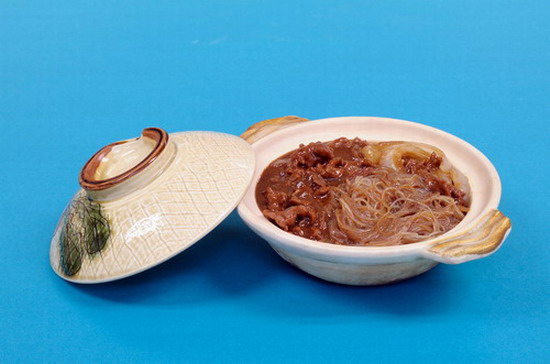
As it is getting cold, many people enjoy eating casserole dishes. We would like to provide some safety tips on preparing Satay Beef and Mung Bean Vermicelli Casserole this time. By ensuring food safety when preparing this steaming hot dish, your family can enjoy the food safely.
Ingredients
| Fresh beef | 150 grams (about 4 taels) |
|---|---|
| Mung bean vermicelli | 50 grams (about 1 tael) |
| Onion | 1/2 piece |
Seasoning
| Light soy sauce | 1 teaspoon |
|---|---|
| Corn flour | 1 teaspoon |
| Sugar | 1 teaspoon |
| Pepper powder | a little |
| Satay sauce | 2 tablespoons |
| Dark soy sauce | 1 tablespoon |
Steps:
- Cut beef into slices. Add light soy sauce, corn flour, sugar and pepper powder. Marinate for 15 minutes.
- Soak mung bean vermicelli in boiled water until tender.
- Rinse and cut onion into strips.
- Add oil into wok. Stir fry the beef in the wok lightly. Dish up for later use.
- Preheat the casserole and add a tablespoon of oil. Add onion strips, stir fry until they smell good. Then add satay sauce, dark soy sauce and a bowl of water. Add mung bean vermicelli and beef when the water is boiling. Cook until the sauce thickens and the ingredients are thoroughly cooked.
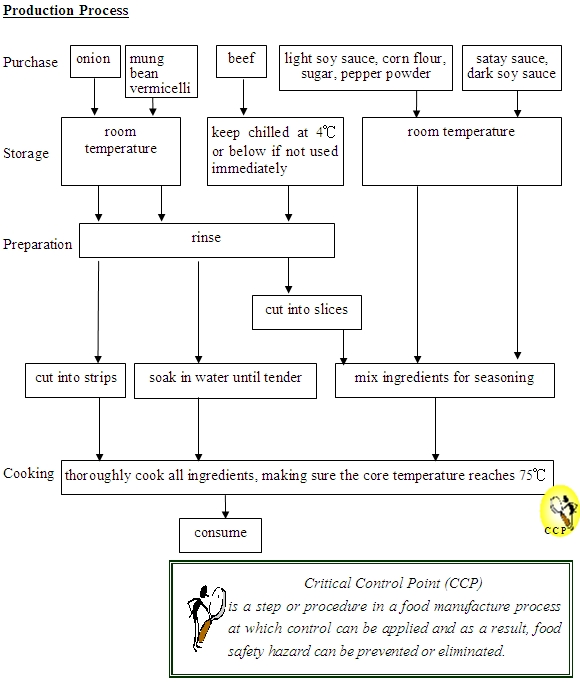
Safety Tips on Production of Satay Beef and Mung Bean Vermicelli Casserole
- Purchase
- Purchase the ingredients from reliable and hygienic shops.
- When buying the ingredients, make sure that:
- the ingredients are fresh and wholesome.
- the fresh beef is purchased from a licensed fresh provision shop.
- the onion is neither damaged nor bruised on the surface.
- prepackaged food items (e.g. mung bean vermicelli, satay sauce) are used before the expiry date.
- Storage
- Store the ingredients at safe temperature as soon as possible.
- Beef not for immediate use should be stored in a refrigerator. The temperature inside the refrigerator should be checked regularly with a thermometer to ensure that the fridge remains at 4℃ or below.
- Raw beef should be stored in a container with a lid and put under cooked food or ready-to-eat food to avoid cross-contamination.
- Practise the first-in-first-out principle for storage.
- Store the ingredients at safe temperature as soon as possible.
- Preparation
- Before cooking, wash all food contact surfaces (including worktops, chopping boards and utensils) thoroughly.
- Before cooking / in the course of preparing food, wash hands thoroughly with running tap water and liquid soap.
- Use two different sets of utensils (including knives, chopping boards, bowls and chopsticks) to handle raw food and cooked food separately.
- Before cooking, rinse the beef, mung bean vermicelli and onion.
- Marinated beef not for immediate cooking should be stored in a refrigerator at 4℃ or below.
- Cooking
- The food should be thoroughly cooked before consumption until the meat juice becomes clear and not red.
- Use a clean food thermometer to measure the core temperature of the food, which should reach at least 75℃.

- Consumption
- The cooked food should be consumed as soon as possible. It should not be kept at room temperature for more than 2 hours.
Food News
Turn and Look for Healthier Food Choices
Nutrition Labelling Series - Nutrient Reference Value
With effect from 1 July 2010, the actual values of energy and seven specified nutrients (i.e. protein, total fat, saturated fat, trans fat, carbohydrates, sugars and sodium) must be provided in nutrition labels. In addition, food manufacturers can voluntarily present the energy and nutrition contents in a relative amount expression. In this issue, we will focus on the questions concerning the "Nutrient Reference Value" (NRV).
Q1: How to establish the "NRV"?
"NRVs" are derived for nutrition labelling purposes. The CFS recommends the trade to adopt the "Chinese NRV" as a reference value. The "Chinese NRV" is derived from recommended intake levels of various nutrients for a healthy diet based on a 2000-kilocalorie diet.
Q2: Why do different countries adopt different sets of "NRVs"?
As some of the prepackaged food products available in Hong Kong are imported from overseas countries, some of these products may use different sets of "NRVs", such as Daily Value (DV) adopted in the United States or Daily Intake (DI) in Australia.
Q3: Are there any difference in "NRVs" among different countries?
Based on the public health conditions and criteria for setting "NRVs" in different countries, "NRVs" adopted by individual country may differ. For example:
| Carbohydrates (g) | Total fat (g) | Sodium (mg) | |
|---|---|---|---|
| Chinese NRV | 300 | 60 | 2 000 |
| Daily Value adopted by United States | 300 | 65 | 2 400 |
| Daily Intake adopted by Australia | 310 | 70 | 2 300 |
Q4: What is the difference between "%NRV" and "NRV"?
"% NRV" refers to the expression of nutrient contents in a specific amount of food on the basis of percentage of "NRV", usually ranging from 0% to 100%. Take a carton of milk beverage containing 130 mg sodium as an example, the amount of sodium is equivalent to 7% of the "Chinese NRV".
Q5: How to apply "%NRV"?
A high "%NRV" means the food contains a lot of a nutrient whereas a low "%NRV" means it contains just a little. A general and simple rule is to look for food that has lower "%NRV" for nutrients that you need to limit (e.g. total fat, saturated fat, sodium and sugars), and higher "%NRV" for nutrients that are good for your health (e.g. dietary fibre).
Q6: As food manufacturers may use different sets of "NRVs" adopted by different countries, the same nutrient value may express as different "%NRVs". In this case, how should various "%NRV" be applied?
Though the "NRVs" of the same nutrient may differ among countries, you can still follow the simple rule mentioned in the Answer of Question 5. In addition, whenever using the information on nutrition labels, besides referring to the relevant percentage, the best practice is to check the actual nutrition contents to get a nutritional overview of the product and make healthy food choices.
Briefing of Activities
I. Efforts of the Centre for Food Safety in the East Asian Games
The Fifth East Asian Games (EAG) which lasted for nine days had been held between 5 and 13 December 2009. It hosted 22 sports events in 22 competition venues across 11 districts. To cope with the operation of the EAG and to ensure food safety during the events, the CFS set up a Food Safety Advisory Team comprising of specialists in August. Recommendations were made by the Team to the food trades, which included hotels, restaurants and caterers to assist them in implementing a Food Safety Plan based on the principles of the Hazard Analysis and Critical Control Point (HACCP) System. The CFS had also taken an array of measures, such as conducting surveillance and inspections on food suppliers, providing training on food safety for their staff and taking food samples for microbiological and chemical testing, with a view to enhancing food safety.
Legislation
I. Preservatives in Food Regulations
To tie in with the latest developments in food science and technology and to keep abreast of international standards, the Government tabled the Preservatives in Food (Amendment) Regulation 2008 (Amendment Regulation) at the Legislative Council in April 2008. The Amendment Regulation having been enacted by the Legislative Council will take effect on 1 July 2010. During the transitional period between the enactment of the Amendment Regulation and the date when the Amendment Regulation comes into force, it is legally in order for the trade to follow either the existing Regulation or the Amendment Regulation. The amendments include the amendment of the definition of antioxidant and the adoption of the principles of the Food Category System in the regulation of preservatives in food. The Amendment Regulation will not only provide the trade with clearer information in the use of preservatives and antioxidants, but also enable the Government to use internationally recognised risk assessment and management principles to continue to protect public health and enhance customer confidence in food safety.
Although at the permitted level of use and under normal level of consumption, food containing preservatives and antioxidants would not lead to health problems, people with allergic conditions, such as asthma patients, may experience hypersensitive reaction to certain preservatives such as sulphur dioxide in food. Such consumers should read the ingredient list when buying food to see whether those preservatives or anti-oxidants that they are allergic to are used in the food.
Details of the Regulations are available on this web page:
http://www.cfs.gov.hk/english/food_leg/food_leg_pf.html#pf_section3
II. Harmful Substances in Food Regulations
The Harmful Substances in Food Regulations made under the Public Health and Municipal Services Ordinance (Cap. 132) regulates harmful substances in food. The Regulations prescribe the maximum concentrations of various harmful substances in food and specify the substances prohibited for use in food. An offender is liable to a maximum fine of $50,000 and imprisonment for six months.
In light of the melamine incident last year, the Government made a legislative amendment to the Regulations. On 23 September 2008, the Harmful Substances in Food (Amendment) Regulation 2008 was published in the Gazette to control the use of melamine in food.
Details of the Regulations are available on this web page:
http://www.cfs.gov.hk/english/food_leg/food_leg_hs.html#hs_reg3